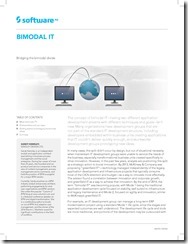 I wrote a paper a few months back on bimodal IT: a somewhat controversial subject, since many feel that IT should not be bimodal. My position is that it already is – with a division between “heavy” IT development and lighter-weight citizen development – and we need to deal with what’s there with a range of development environments including low-code BPMS. From the opening section of the paper:
I wrote a paper a few months back on bimodal IT: a somewhat controversial subject, since many feel that IT should not be bimodal. My position is that it already is – with a division between “heavy” IT development and lighter-weight citizen development – and we need to deal with what’s there with a range of development environments including low-code BPMS. From the opening section of the paper:
The concept of bimodal IT – having two different application development streams with different techniques and goals – isn’t new. Many organizations have development groups that are not part of the standard IT development structure, including developers embedded within business units creating applications that IT couldn’t deliver quickly enough, and skunkworks development groups prototyping new ideas.
In many cases, this split didn’t occur by design, but out of situational necessity when mainstream IT development groups were unable to service the needs of the business, especially transformational business units created specifically to drive innovation. However, in the past few years, analysts are positioning this split as a strategic action to boost innovation. By 2013, McKinsey & Company was proposing “greenfield IT” – technology managed independently of the legacy application development and infrastructure projects that typically consume most of the CIO’s attention and budget – as a way to innovate more effectively. They found a correlation between innovation and corporate growth, and greenfield IT as a way to achieve that innovation. By the end of 2014, the term “bimodal IT” was becoming popular, with Mode 1 being the traditional application development cycle focused on stability, well suited to infrastructure and legacy maintenance and Mode 2, focused on agility and innovation, similar to McKinsey’s greenfield IT.
Read on by downloading the paper from Software AG’s site; right now, it looks like registration isn’t required.

I’m glad to see this approach validated and codified, as I’ve always been a Mode 2 sorta guy. It’s always been hard for me to encapsulate into an elevator pitch what I offer to a mainstream organization. It has also been challenging to sell an agile approach to a one-size-fits-all enterprise committed to the waterfall model.
Interesting thoughts. I have seen another form of bimodal IT in Education. Its the collaboration between “traditional” IT, responsible for infrastructure and networking and shared applications, and Education Technology/Academic Technology, which is responsible for productivity in the classroom and elsewhere.
The perfect marriage of these two halves of the sum is Palm Beach County School District. They have formed an inseparable bond between these two parts of their organization, which in the not so distant past might not have even spoken to each other.
I realize this collaboration is off topic, except that I’d like to say I think IT as we know it is actively morphing right now. Glass houses and silos aside, I’d say IT is getting smarter about its users, which I think is part of the point of your writing. “Traditional” IT can’t be relied upon to create everything for users any more than the average user can be relied upon to build sustainable, safe infrastructure.
Keep up the good work, Sandy. Love reading your stuff!
There are a lot of examples, usually based around the hard-pressed infrastructure on one side, and the user or customer facing apps on the other. Interesting that a lot of people read “bimodal” as “one or the other” when it is really a spectrum, but a spectrum with most of the distribution closer to the two ends.